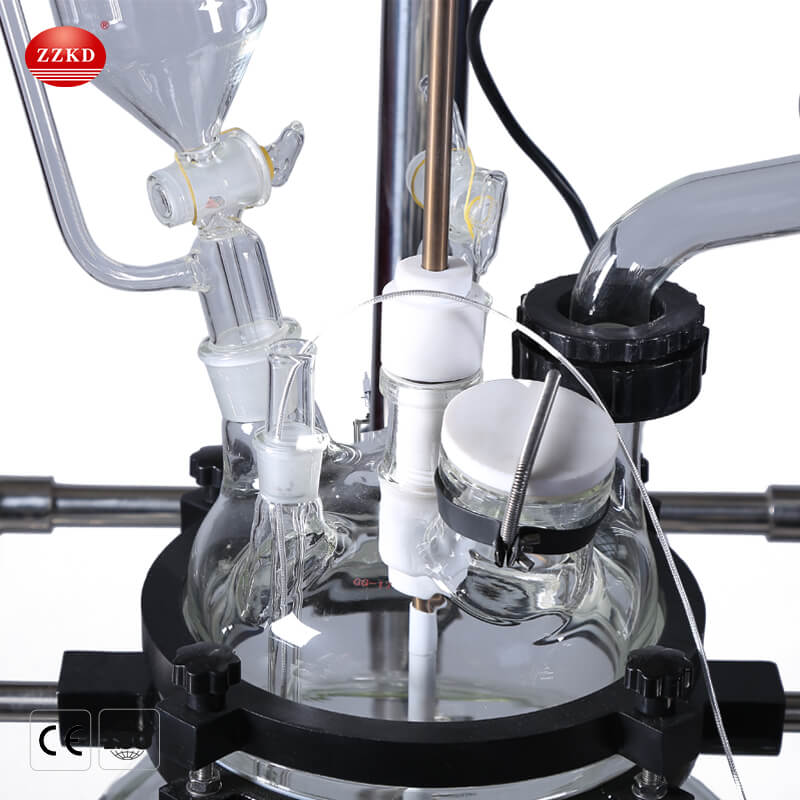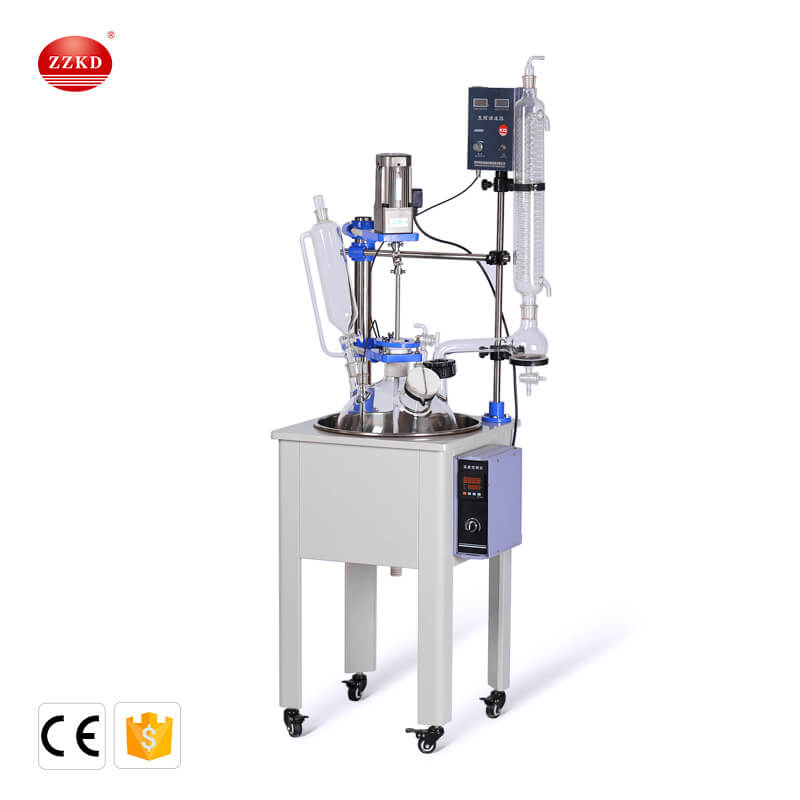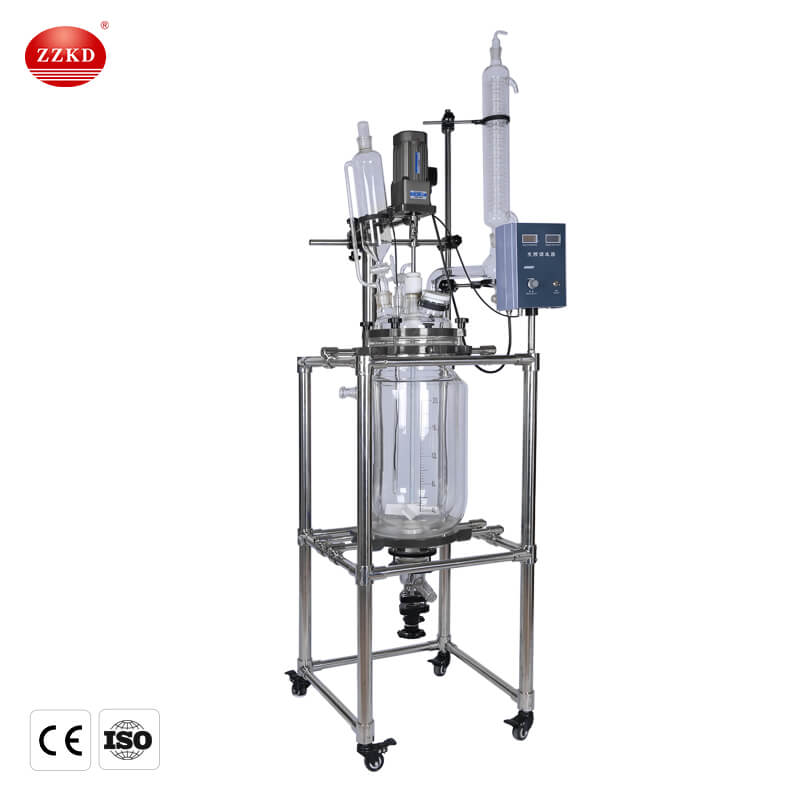20l jacketed glass reactor for sale
The working principle and use of single and double glass reactors
Glass reactors are ideal equipment for modern chemical sample experiments, biopharmaceuticals and new material synthesis. They are widely used in laboratories. We have talked about the classification and selection of 100l glass reactor. Let's take a closer look at the following issues:
1. What is the general working principle of the glass reactor?
The glass reactor is stirred and reacted under normal pressure or negative pressure in a closed container under the set constant temperature condition, and can control the evaporation and reflux of the reaction solution. Generally, there are single-layer glass reactors and double-layer glass reactors. (Supplementary Note: Installation Precautions for Glass Reactor)
2. What are the uses of the single-layer glass reactor and what is its working principle?
The single-layer glass reactor can provide high temperature reaction (the maximum temperature can reach 300℃); it can also be evacuated to do negative pressure reaction. The single-layer glass reactor can carry out various solvent synthesis reactions under constant temperature conditions. The reaction part of the instrument is a controllable and fully sealed structure. It can continuously inhale various liquids and gases by using negative pressure, and can also do reflux or distillation at different temperatures.
The working principle of the single-layer glass reactor is that the reactor body is directly heated by the silver film heating plate, so that the materials in the reactor can be heated at a constant temperature, and stirring can be provided. The materials are reacted in the reactor, and the evaporation and reflux of the reaction solution can be controlled. After the reaction is completed, the lid and motor part of the single-layer glass reaction kettle are mechanically lifted (electric lifting is optional), and the kettle body can be rotated 360 degrees to facilitate material dumping and discharging, and the operation is extremely convenient. It is an ideal equipment for modern chemical sample, medium sample experiment, biopharmaceutical and new material synthesis.

3. What are the uses of the double-layer glass reactor and what is its working principle?
The interlayer of the double-layer glass reactor can be used for high-temperature reaction (the highest temperature can reach 300℃), and it can also be used for low-temperature reaction (the low temperature can reach -80℃); the double-layer glass reactor can be evacuated for negative pressure reaction. The double-layer glass reactor can carry out stirring reaction at room temperature, high temperature reaction, negative pressure vacuum distillation reaction, separation and extraction, distillation reflux reaction, and concentration reaction.
The double-layer glass reactor is designed with double-layer glass. Its working principle is: put the reaction solvent in the inner layer of the glass for stirring reaction, and the interlayer can be connected to different cold and heat sources (refrigerated liquid, hot water or hot oil) for circulation Heat or cool the reaction. Through the interlayer of the double-layer reactor, a constant temperature (high temperature or low temperature) hot melt medium or cooling medium is injected to heat or cool the materials in the reactor at a constant temperature. At the same time, the stirring reaction can be carried out under normal pressure or negative pressure according to the requirements of use.
Matters needing attention when debugging and installing explosion-proof single-layer glass reactor
Explosion-proof single-layer glass reactor is a kind of experimental equipment integrating vacuum, distillation, reflux, stirring, constant temperature water bath or oil bath. This multi-functional vacuum constant temperature single-layer glass reactor can carry out various biochemical reactions under constant temperature conditions. and synthetic reactions. The single-layer glass reactor is a fully closed system as a whole. It can use the circulating water vacuum pump to generate negative pressure to inhale various liquids or gases, and it can also be refluxed or distilled under different temperature conditions. A cooling coil is added, and a low-temperature coolant circulation pump is configured for low-temperature operation.
Debugging and trial installation of explosion-proof single-layer glass reactor:
1. The main frame is placed on a horizontal work surface close to the power supply.
2. The water bath is placed on the stainless steel floor of the main frame.
3. The glass part is installed in a suitable position according to the experimental needs.
4. The stirring motor is installed on the main frame, and the stirring chuck is aligned with the stirring rod, which is firmly fixed.
5. The electrical control part is installed on the main frame, and the five-core plug of the motor is connected with the electrical control part.
6. Check all connections, and after confirming that they are correct, add water to the water bath to a suitable position, and then insert the back end cable plug of the right electrical appliance into the three-wire socket. The three-wire socket should be grounded with a ground wire. Set the bath temperature according to the heating requirements.
7. Start the motor, first slowly adjust the knob of the governor to check whether the stirring rod of the motor runs smoothly. If there is any swing, it is necessary to re-adjust the concentricity of the motor shaft and stirring rod. The adjustment is accurate and the stirring rod does not oscillate before the operation can be carried out. .
8. After the reaction test is completed, the power supply should be turned off.

Maintenance and maintenance of double-layer glass reactor
Reasonable installation and correct operation of the equipment are the prerequisites to ensure the stable operation of the double-layer glass reactor. According to the industry, in the process of working in the double-layer glass reactor, some places are actually very easy to be ignored by users. In this regard, the industry has made a summary based on experience, and the author has made a brief arrangement.
First, pay attention to heat preservation. It is understood that due to the small thickness of the interlayer in the double-layer glass reactor, the thermal insulation performance is poor. In the process of using high temperature and low temperature, users need to use thermal insulation materials to protect the kettle body.
At the same time, the user needs to wrap the reactor body and the liquid-conducting pipes with thermal insulation materials, and pay attention to the thickness of the thermal insulation layer to ensure a good thermal insulation effect.
Second, the choice of temperature control medium. Generally speaking, according to the required reaction temperature, the user will select a temperature control medium with different properties as the heat transmission medium for the reaction. Choose ice ethanol bath for low temperature, water bath for normal temperature, and oil bath for high temperature.
It is understood that usually manufacturers will choose the corresponding heating medium according to their own products.

Third, the storage location should be reasonable. The double-layer glass reactor is used as a reaction amplification test device, and the volume is usually 50-150L, and the volume can be customized in specific cases. Therefore, the scale of the test should not be underestimated. Since the kettle body is made of glass, stainless steel is the bracket and the legs are casters, the storage location needs to be carefully selected.
As far as storage conditions are concerned, although the casters can be fixed with foot buckles, the stability is not strong. Therefore, during the storage process, the user should choose a flat place to lay it, and keep the mechanical stirring center consistent with the reaction kettle, otherwise it will easily shake and become unstable and cause safety accidents. In addition, it must be placed in a well-ventilated place.
Fourth, precautions for feeding. Since the double-layer glass reactor is an independent reaction rack and the reserved feeding port is small, the feeding process is difficult.
In this regard, it is suggested that solid reagents can be formulated into solutions and added to the kettle, and liquid reagents can be pumped into the kettle through the matching water pump or oil pump. In particular, when the reaction material is added to the reaction kettle through a constant pressure dropping funnel or a common dropping funnel, a corresponding mobile ladder needs to be matched so that the staff can add the test material.
The double-layer glass reactor is designed with double-layer glass, and the reaction solvent can be placed in the inner layer to stir the reaction. The interlayer can provide different cold and heat sources (refrigerated liquid, hot water or hot oil) for high temperature reaction (with corresponding circulating oil bath, high temperature can reach 300 ℃) or low temperature reaction (with corresponding low temperature refrigerant circulation system) , low temperature up to -80 ℃), or choose heating and cooling integrated circulation equipment. Under the set constant temperature condition, in a closed glass reactor, the stirring reaction can be carried out under normal pressure or negative pressure according to the requirements of use, and the reflux distillation of the reaction solution can be carried out. When in use, the reaction solution can be drawn out to realize vacuum reaction. It is an ideal test and production equipment for modern fine chemical industry, biomedicine and new material synthesis. This design makes testing safer and more convenient.


